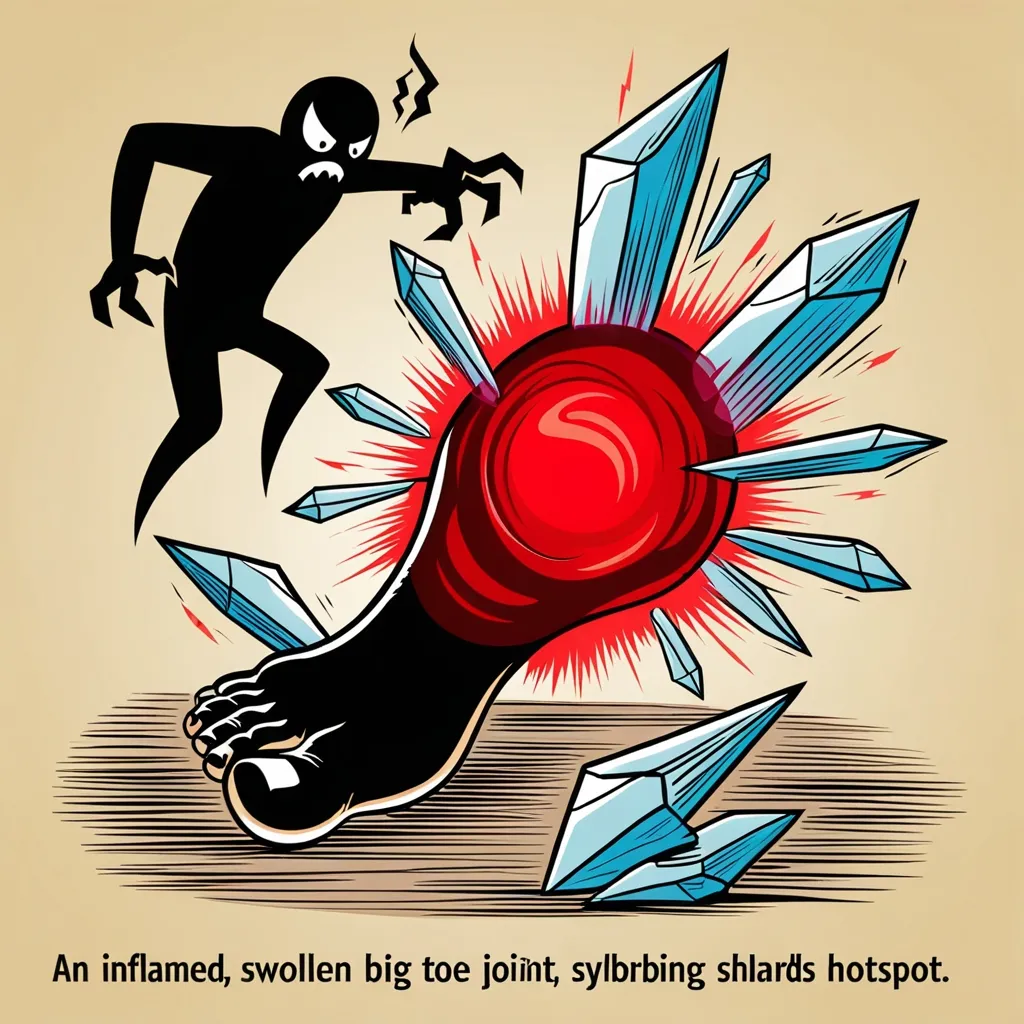Gout: Navigating the Painful Path of This Arthritic Beast
Gout is a sneaky form of arthritis that’s basically like having a tiny fireball explode in your joint. Generally, it takes on the role of an uninvited guest, causing excruciating pain and swelling, mostly in the big toe. Occasionally, it throws a wild party in other joints like knees or ankles. The culprit? Uric acid. When too much uric acid runs wild in your bloodstream, it starts forming crystal deposits in your joints, leading to those dreaded gout attacks.
Understanding Gout
Let’s dig into what makes gout tick. Imagine your joints are prized possessions, and suddenly, these uric acid crystals decide to turn them into their personal hangout spots. When your body can’t keep up with the excess uric acid—it’s either making too much or not flushing it out effectively—it spells trouble. Usually, uric acid is pretty chill; it dissolves in your blood and exits via your kidneys. But when it overstays its welcome, it locks and loads into your joints, becoming the instigator of some serious drama.
Gout Symptoms: The Drama Begins
Imagine drifting off to sleep, only to wake up feeling like your joint is literally on fire. That’s a typical gout attack—unpredictable, intense, and often showing up at night. The pain ranges from throbbing to devastating, your affected joint is hot to the touch, swollen, and angry red. Even the gentlest brush against it feels like torture. These attacks don’t last forever; they’re more like really, really unpleasant houseguests who stay for a few days or up to a couple of weeks. In-between these attacks, everything might seem perfectly fine, lulling you into a false sense of security.
Risk Factors: Who’s the Most Likely to Get Invited to Gout’s Party?
Certain folks are more likely to get hit by gout’s storm. Middle-aged men and postmenopausal women are more often targeted, especially if there’s a family history of gout tormenting the family tree. Downing lots of alcohol, taking diuretics, and having conditions like high blood pressure, kidney disease, thyroid issues, diabetes, or sleep apnea doesn’t help matters—they all roll out the red carpet for gout.
Treating Gout: The Relief Squad
If you’re staring down a gout attack, medications are typically the first line of defense. Doctors often prescribe nonsteroidal anti-inflammatory drugs (NSAIDs) like ibuprofen and naproxen, colchicine, or corticosteroids to tackle inflammation and this agonizing pain. While these meds are pretty effective at beating back gout symptoms, they can come with side effects like stomach pain, nausea, and unfortunately, kidney stones.
Preventing future gout attacks involves taming uric acid levels in the blood. Enter xanthine oxidase inhibitors like allopurinol and febuxostat, and uricosuric agents like probenecid. These meds get to work by either putting a stop to excess uric acid production or helping the body get rid of it more efficiently, making future gout attacks far less likely.
Lifestyle Changes: The Necessary Shift
Beyond pills, lifestyle overhauls play a huge role in managing gout. Avoiding purine-rich foods like red meats, organ meats, and certain seafood (hello, anchovies and sardines) is a significant step. Dialing back on alcohol consumption, especially beer and spirits, is crucial since they can hike up uric acid levels. Swapping these for low-fat dairy products and plenty of water makes a difference, promoting better health overall.
Physical activity and maintaining a healthy weight are also key. Low-impact activities like walking, bicycling, and swimming are gentle on the joints and can seriously reduce the likelihood of gout attacks. Cutting out smoking and finding ways to manage stress levels help support overall wellness, reducing gout’s grip on life.
Home Remedies: Nature’s Little Helpers
Besides popping pills, various home remedies can also play a supportive role in tackling gout. Tart cherries, magnesium supplements, ginger, diluted apple cider vinegar, celery, nettle tea, dandelion, and milk thistle seeds are often recommended—kitchen treasures that might help lower uric acid levels. While these natural aids are worth a try, bear in mind they’re typically not enough to manage gout on their own, but can complement medical treatments nicely.
Complications from Neglected Gout
Leaving gout untreated is like letting a small fire smolder—it can flare up into something much worse. Chronic gout can cause hard lumps called tophi to form in joints and nearby tissues, leading to permanent damage and deformity. It’s not just about enduring nasty flare-ups; over time, untreated gout morphs into gouty arthritis, a harsher form of arthritis fraught with severe pain and lasting joint damage.
In extreme cases where joints are significantly damaged, surgery might be on the table. From removing tophi to fusing or replacing joints, surgical options depend on the level of damage and what’s the most practical fix.
Diagnosing Gout
Pinning down a gout diagnosis often involves a blend of clinical assessment and lab tests. Doctors might take a sample of fluid from the inflamed joint to scrutinize for urate crystals under a microscope. Blood tests can measure uric acid levels, although this isn’t always a tell-all. Imaging tests like X-rays, ultrasound, and dual-energy computerized tomography (DECT) can help rule out other conditions and confirm the presence of those pesky crystals.
Managing Gout Attacks: When Trouble Hits
When a gout attack strikes, seeking medical help is essential. Healthcare providers might suggest over-the-counter painkillers or prescribe heavier artillery to squash the pain and inflammation. Following a prescribed treatment plan and embracing the necessary lifestyle changes goes a long way in dodging future attacks.
Wrapping it Up
In summary, gout is an incredibly painful condition stemming from uric acid buildup in the joints. Proper management includes combining medications and lifestyle alterations to curb the attacks and prevent long-term joint damage. Having a good grasp of gout’s symptoms, risk factors, and treatment options empowers those dealing with it to better control their condition and, ultimately, improve their quality of life.






